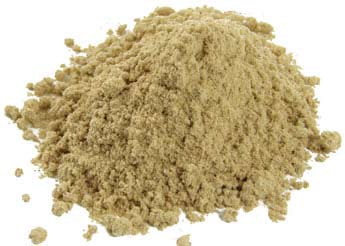Step 2 – Alternative to Mesalamine Pills
– by introducing a special natural product which “coats and soothes” the whole digestive track and alimentary canal (I consider it the alternative natural alternative to the mesalamine product line) – which plays an important role in all classes of IBD related diseases.
This natural product I am referring to is called Slippery Elm Bark Powder (organic). This is the second step in the Alternative Protocol.
Why is it so important to find an ALTERNATIVE to the mesalamines? Mesalamines have potentially dangerous side effects, both short term and long term. Some common side effects can be: hair loss, decreased libido, and joint pains. Some people are allergic to them and get increased abdominal pain, bloating, gas, headaches, terrible watery diarrhea and even bleeding. Others can take the mesalamines for a while and then develop an intolerance to the mesalamines (symptoms noted in above) and mistakenly think their IBD has taken a turn for the worst and they’ve started a flare, when it was just an intolerance to the mesalamines. But the more dangerous long term effects are: kidney and liver damage, and possible kidney and liver failure.
IMPORTANT: If you are on mesalamines, please make sure your doctor is doing regular blood work (every 4 months at least) and urine tests to specifically check that your liver and kidneys are not being affected by the mesalamines. These long term side effects could be life threatening.
Step 2 – Alternative to Mesalamine Pills
Why?
Because what Slippery Elm Bark Powder does is it coats and soothes your whole alimentary canal and digestive track which as a result of Ulcerative Colitis, IBS, IBD, Crohn’s Disease processes, has become inflammed and may be ulcerated; this is equivalent to putting salve on a burn to quiet it down and heal it – what I call the natural and healthy (no side effects) alternative to the medically prescribed mesalamine products. I recommend you take this inexpensive product 3 times a day in its powdered form ( they do make in a pill form, but it won’t have the same powerful coating effect) before meals.
Here’s how I take it:
3 times a day, before each meal, in 2 ounces of water, take 1 full teaspoon of the Organic Slippery Elm Bark Powder then add 2 drops of Honey to it (did you know Honey is a natural anti-microbial?), and mix it thoroughly by smashing the back of the spoon against the glass to smash the lumps into a kind of “gel” or “glue” (for lack of a better term), and then drink it immediately. Note, if you let it sit too long, it will get very thick so you may then need to add some water to it to make it drinkable. A note about the honey, please make sure it doesn’t have any high fructose corn syrup in it, and it is natural. It isn’t a must to add honey, however I like it because it adds a touch of sweetness, and I know of its anti-microbial properties.
Step 2 – Alternative to Mesalamine Pills
Slippery Elm Studies
As reported by the University of Maryland Medical Center:
Overview:
Slippery elm (Ulmus fulva) has been used as an herbal remedy in North America for centuries. Native Americans used slippery elm in healing salves for wounds, boils, ulcers, burns, and skin inflammation. It was also taken orally to relieve coughs, sore throats, diarrhea, and stomach problems.
Slippery elm contains mucilage, a substance that becomes a slick gel when mixed with water. It coats and soothes the mouth, throat, stomach, and intestines; it also contains antioxidants that help relieve inflammatory bowel conditions. Slippery elm also causes reflux stimulation of nerve endings in the gastrointestinal tract leading to increased mucus secretion. The increased mucus production may protect the gastrointestinal tract against ulcers and excess acidity.
There has been little scientific research on slippery elm, but it is often suggested for the following conditions:
- Sore throat
- Cough
- Gastroesophogeal reflux disease (GERD)
- Crohn’s disease and ulcerative colitis
- Diarrhea
- Wounds, burns, boils, psoriasis, and other skin conditions (external)
Plant Description:
Slippery elm is a medium-sized tree native to North America. It can reach well over 50 feet in height and is topped by spreading branches that form an open crown. The red-brown or orange branches grow downward, and the stalkless flowers are arranged in dense clusters. The plant’s leaves are long and green, and they darken in color during the fall. The bark has deep fissures, a gummy texture, and a slight but distinct odor.
Parts Used:
The inner bark is dried and powdered, and used for medicinal purposes.
Available Forms:
Available forms of slippery elm include the following:
- Tablets and capsules
- Lozenges
- Finely powdered bark for making teas or extracts
- Coarsely powdered bark for poultices
How to Take It:
Pediatric
Although there are no scientific studies examining the use of slippery elm in children, it is generally considered to be safe. Adjust the recommended adult dose to account for a child’s weight. Most herbal dosages for adults are calculated on the basis of a 150 lb (70 kg) adult. So if the child weighs 50 lb (20 – 25 kg), the appropriate dose of slippery elm would be 1/3 of the adult dose.
Adult
The following are recommended adult doses for slippery elm:
Tea: Pour 2 cups boiling water over 4 g (roughly 2 tablespoons) of powdered bark and then steep for 3 – 5 minutes. Drink 3 times per day.
Tincture: 5 mL 3 times per day. Note: Contains alcohol.
Capsules: 400 – 500 mg 3 – 4 times daily for 4 – 8 weeks. Take with a full glass of water.
Lozenges: follow dosing instructions on label.
External application: Mix coarse powdered bark with boiling water to make a poultice; cool and apply to affected area. Never apply slippery elm to an open wound.
Precautions:
The use of herbs is a time-honored approach to strengthening the body and treating disease. Herbs, however, can trigger side effects and can interact with other herbs, supplements, or medications. For these reasons, you should take herbs with care, under the supervision of a health care provider.
Slippery elm has no serious side effects. Because it coats the digestive tract, it may slow down the absorption of other drugs or herbs. You should take slippery elm 2 hours before or after other herbs or medications you may be taking.
Scientists think slippery elm is safe in pregnancy and during breastfeeding, but no scientific studies have been done to confirm this. The outer bark of the elm tree, however, may contain substances that could increase the risk of miscarriage, so sometimes pregnant women are advised to avoid slippery elm.
Possible Interactions:
There are no scientific reports of slippery elm interacting with any other medications, although it may slow down the absorption of other drugs or herbs (see “Precautions” section).
Alternative Names:
Red elm; Sweet elm; Ulmus fulva; Ulmus rubra
Reviewed last on: 2/3/2009
Steven D. Ehrlich, NMD, private practice specializing in complementary and alternative medicine, Phoenix, AZ. Review provided by VeriMed Healthcare Network.
Supporting Research
Bock S. Integrative medical treatment of inflammatory bowel disease. Int J Integr Med. 2000;2(5):21-29.
Brown AC, Hairfield M, Richards DG, McMillin DL, Mein EA, Nelson CD. Medical nutrition therapy as a potential complementary treatment for psoriasis — five case reports. Altern Med Rev. 2004;9(3):297-307.
Kemper KJ. Slipper elm (Ulmus rubra or U. fulva). The Longwood Herbal Task Force and The Center for Holistic Pediatric Education and Research. Revised Sept. 29, 1999. Online at https://longwoodherbal.org/slipperyelm/slipperyelm.htm.
Langmead L, Dawson C, Hawkins C, Banna N, Loo S, Rampton DS. Antioxidant effects of herbal therapies used by patients with inflammatory bowel disease: an in vitro study. Aliment Pharmacol Ther. 2002;16(2):197-205.
Newall C, Anderson L, Phillipson J. Herbal Medicines: A Guide for Health-care Professionals. London: Pharmaceutical Press; 1996:248.
Rakel D. Rakel: Integrative Medicine, 2nd ed. Philadelphia, PA: Saunders Elsevier Inc.; 2007:43.
Rotblatt M, Ziment I. Evidence-based Herbal Medicine. Philadelphia, Penn: Hanley & Belfus, Inc.;2202:337-338.
BTW, Slippery Elm Bark Powder is great for
animals too! When my dog had “kennel cough”,
or a scratchy throat, I sprinkle some Slippery
Elm Powder on her wet food, and mix it up
really well. And it helps her pretty quickly –
(within a day or two)!
Where do I buy my Slippery Elm Bark Powder (organic)?
I have done a thorough search
for the best priced, best quality
Organic Slippery Elm Bark Powder
and (Click the link for more info),
for 4 oz. @ $12.00 or
by the pound, approx. $37.50 per pound,
and at 3 teaspoons a day, it will last
a good year!
and here is where you can get it



